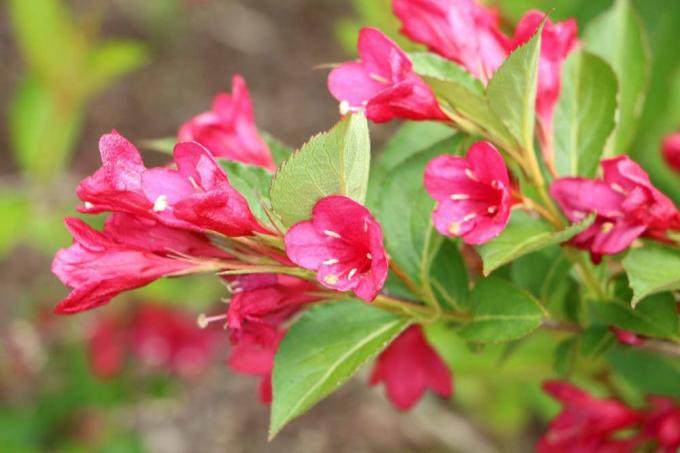
table of contents
- Plant selection
- Planting time
- Plant spacing
- Flowering hedge plants
- From B to D
- From F to G
- From L to S
- From T to W
- Planting plan
Anyone looking for a natural privacy screen or a lively alternative to a garden fence usually ends up with thuja or hornbeam. But there are also real beauties among the hedge plants that set wonderful accents in the garden once a year: flowering hedge plants. In this article we have put together for you which flowering shrubs are suitable as hedge plants.
Plant selection
There is a whole range of flowering trees to choose from, which are suitable for creating hedges. When it comes to the selection of trees, the most important thing is which function the flower hedge should fulfill. With low variants of the hedge plants, for example, beds can be excellently demarcated or paths bordered. High hedges with thick foliage offer good privacy. While some plants already enchant the viewer with their blooming splendor in spring, others bloom in summer or even in the winter months. Some also bear fruit, so that they bring color to the garden again in late autumn.
The following factors are important for the selection:
- Height
- Flower color
- Location
- Soil condition
- Compatibility with each other
Anyone who opts for a flowering hedge in the garden should be aware that these hedge plants cannot be trimmed very accurately and narrowly. Their growth is therefore rather loose. Most flowering shrubs also shed their leaves in autumn, but there are also a few evergreen species that provide year-round privacy.

Planting time
Both spring and autumn are suitable for creating flowering hedges. However, you should bear in mind that most shrubs do not develop their full bloom until the second year after planting. So that the hedge remains easy to care for, you should use shrubs that are well hardy.
Plant spacing
Measure the distances between the individual hedge plants so generously that the flowering shrubs do not hinder each other's growth. If you choose trees with a similar height, the maintenance measures will be much easier.
- taller hedge plants: about 1 m apart
- low hedges: around 50 to 70 cm
- Hedges planted in a zigzag: 70 cm
Flowering hedge plants
From B to D
Farmer's jasmine / pipe bush (Philadelphus coronarius)
This hardy ornamental shrub is a fast-growing wood that forms very double, snow-white scented flowers in early summer. The farmer's jasmine is very undemanding and grows without problems in almost any location and soil.
- white, double flowers in June and July (smell pleasant)
- Growth: 30-50 cm per year
- Height: 2 to 3 m
- tolerates all soils with uniform moisture
- well tolerated by pruning, hardy

Blood currant (Ribes sanguineum)
The currant grows as a compact shrub with numerous, basal shoots. Since the flowering ornamental shrub is densely branched, it is also ideal as a privacy screen. Its pure red flowers appear before the foliage sprouts in spring.
- dark red, pendent flower clusters in April to May
- Soil: fresh, humic
- Growth: 10-15 cm per year
- Height: up to 2 m

Bridal Spear / White Rispenspiere (Spiraea cinerea)
The early bridal spar, also known as white panicle or snow spar, is very popular in our gardens. This is not least due to their abundant flowering. The individual flowers are small, but they are densely packed in elongated umbels that overhang like an arch in older plants.
- white umbels in April to May
- Location: sun
- Soil: thrives on almost any type of soil
- Growth: 15-40 cm per year
- Height: 1.5 to 2 m

Box-leaved barberry (Berberis buxifolia ´Nana´)
As the name buxifolia already suggests, its leaves are similar to the box tree. Just like the boxwood, the barberry has dark green, egg-shaped leaves and is evergreen. The blooming dwarf shrub reaches a maximum height of one meter. The long shoots are lightly thorny and are therefore not only suitable as a good privacy screen, but also protect against unwanted entry into the garden. This hedge can also be cut very narrowly.
- golden yellow flowers in May
- Soil: well drained, otherwise undemanding
- Growth: about 5 to 10 cm per year
- Height: 50 to 80 cm
- evergreen
- good cut tolerance and winter hardiness

Deutzia / Maiblumenstrauch (Deutzia scabra or magnifica)
Double Deutzia species are particularly attractive as hedge plants because the flowers are particularly intense. In early summer, the may flower bush forms white or pale pink flower umbels that are up to 12 cm long and are close together.
- white or light pink umbels in May to June
- Growth: 20-40 cm per year
- Height: 3 to 4 m
- grows on all normal garden soils

From F to G
Forsythia (Forsythia)
Forsythia, also known as gold bells, is one of the classics among flowering hedge plants. The shoots of the medium-high shrub hang over arching when they are not cut. Before the fresh green leaves sprout, bright yellow flowers form over the entire branches from March to April.
- bright yellow flowers in March to April
- Soil: normal garden soil
- Growth: 20-35 cm per year
- Height: 2 to 3 m

Lilac (Syringa vulgaris)
The most famous scented shrub in our gardens is the lilac. With its large panicles of flowers, it exudes an intense, beguiling smell. Lilac is one of the typical spring bloomers in May. In addition to the different varieties of common lilac, which can reach a height of over three meters, there are also dwarf varieties.
- intensely fragrant flowers in white, purple and, rarely, pink tones
- Growth: 20-40 cm per year (dwarf varieties less)
- Height: depending on the species, very easy on cutting
- Location: sunny to shady
- Soil: sandy, humic
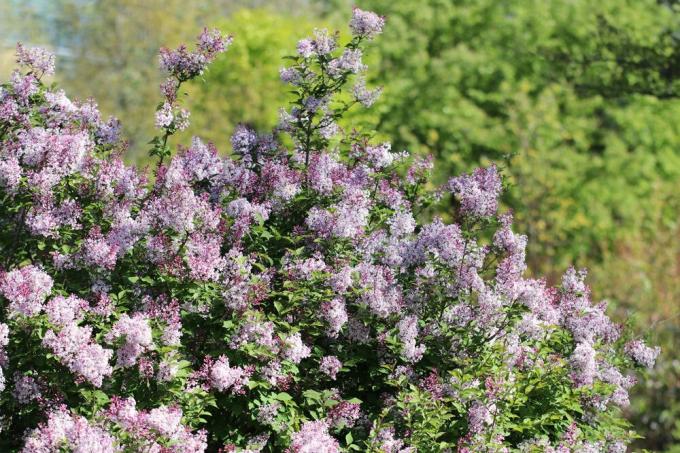
Loquat (Photinia fraseri)
One of the most beautiful medlars is the ´Red Robin´ variety. In spring it shoots bright red and thus provides color accents in the garden. Before the leaves turn green in summer, the numerous umbels appear in May to June, which form a wonderful contrast to the red leaves.
- evergreen
- Flowers in red or white from May to June
- Growth: 30 to 50 cm per year, fast growing
- Height: 3 to 5 m
- Location: sunny to partially shaded
- Soil: humus and rich in nutrients
- only partially hardy in cold locations

From L to S
Privet (Ligustrum vulgare)
The true beauty of the privet is often not shown to advantage because it is strictly trimmed as a hedge. If you let it grow freely, a loose, upright shrub develops that forms long, white flower umbels.
- white umbels in June / July
- some species are evergreen
- also available with variegated leaves
- Growth: 40-100 cm per year, very fast growth
- Height: 3-4 m
- Location and soil: undemanding
- well hardy
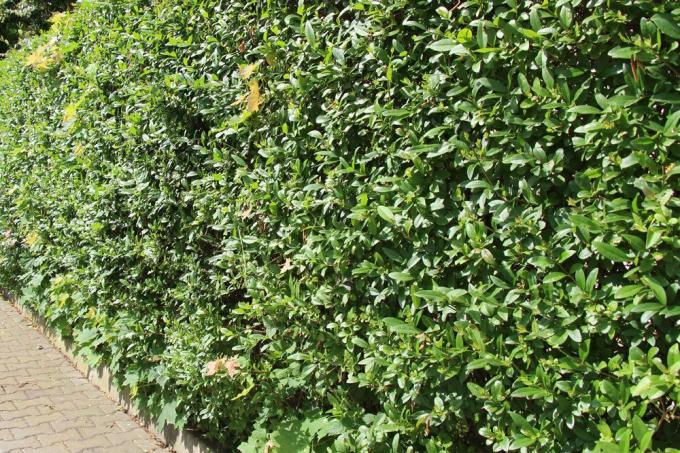
Mother of pearl bush (Kolkwitzia amabilis)
The mother-of-pearl bush, also known as Kolkwitzia, sets romantic accents in the garden with its flowers. In autumn, the leaves mainly turn brown and light orange and red tones.
- pink to red-white flowers in May to June
- Growth rate: 20-50 cm per year (fast growing)
- Height: 2.0 to 3.5 m

Sloe / blackthorn (Prunus spinosa)
The sloe, also called hedge thorn or black thorn, belongs to the stone fruit family. These are thorny shrubs that are covered with white flowers in early spring before the foliage sprouts. The shrub is one of the native plants and is very undemanding.
- numerous white flowers in April and May
- blue fruits (sloes) in autumn
- Soil: sandy, often calcareous
- Growth: 20-30 cm per year
- Height: 2-3 m
- well tolerated and hardy
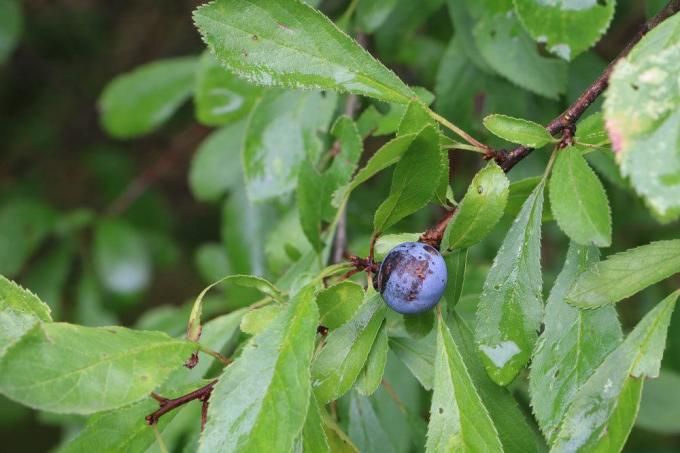
Snowball (Viburnum varieties)
The common viburnum is a native wild wood with white, fragrant umbrella flowers that contrast nicely with the strong green leaves. The leaves of the stiffly upright shrub look similar to those of the maple. In autumn the foliage turns orange-red to wine-red. Palm-sized fruit umbels form from the white flowers with initially yellow, later red fruits, which look very decorative in autumn and winter.
- white or light pink umbrella flowers from May to June
- Growth: 15-40 cm per year
- Height: up to 4 m
- evergreen varieties available
- Location: sun to shade
- Soil: loamy-humic, often calcareous

Snowforsythia (Abeliophyllum distichum)
The snow forsythia is one of the real rarities. In mild locations, the shrub blooms from January, otherwise from March. Numerous bell-shaped, white flowers with an almond-like scent open from reddish buds.
- white flowers in winter to spring
- Growth: 20-30 cm per year
- Height: up to 1.5 m
- location sheltered from the wind in rough locations
- Soil: nutrient-rich and loose
From T to W
Teufelsstrauch / Rote Fasanenspiere (Physocarpus opulifolius)
The blood-red foliage color of the shrub, also known as the dark red bladder spar diabolo, forms a beautiful contrast to the pink-whitish flowers, which appear in rounded umbels in June. The flowers ripen into red follicles with a bubble-like appearance.
- white to pink flower umbels in June
- Growth: fast growing (30-50 cm per year)
- Height: 2.0 to 2.5 m
- dark red foliage

Weigelia (Weigelia)
Weigela is an easy-care flowering shrub with funnel-shaped or bell-like flowers that form directly after the lilac blossom. Some varieties reach heights of over three meters, while others only reach a height of just under one meter. In good years there is a second bloom in autumn.
- pink, red, yellow or white flowers in June and July
- Growth: fast growing (30-50 cm per year)
- Height: depending on the variety
- overhanging in old age
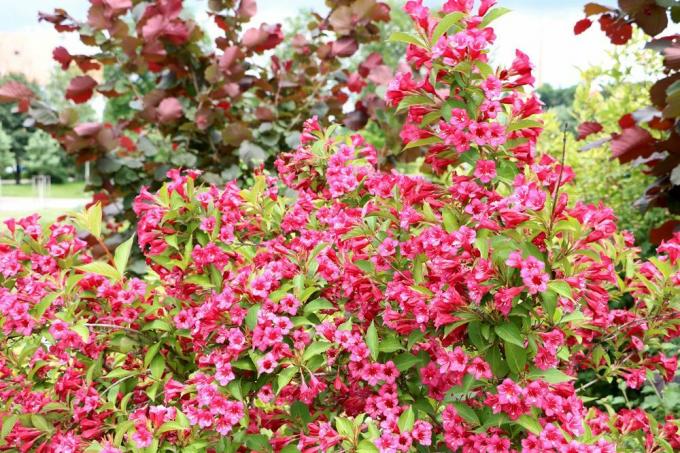
Wild rose / sand rose (Rosa mollis)
The wild rose or sand rose grows excellently on sandy soils and is therefore also suitable for locations where it is otherwise difficult to cultivate hedges. In early summer, fragrant light pink flowers adorn the shrub. From September onwards, the red rose hips ripen and remain on the plant for the entire winter. From October the sand rose appears in a yellow to orange-red autumn dress.
- large pink flowers in June and July
- Growth: 20-40 cm per year
- Height: 1.5 to 2 m
- Location: sunny
- well hardy

Winter bloom (Chimonanthus praecox)
Not only the flowers, which appear on the bush in mild locations as early as December, otherwise from March, are fragrant, but also the bark and leaves.
- creamy yellow with a reddish center in the winter months
- Growth: 10-20 cm per year
- Height: up to 3 m
- Location: sheltered from the wind
- Soil: rich in nutrients
- young plants need winter protection

Winter honeysuckle (Lonicera x purpusii)
This rare species of honeysuckle produces white flowers with a delicate scent of violets from December. Depending on the weather conditions, the blossoms last until April. The branches hang over elegantly.
- white flowers from December, fragrant
- Height: up to 2 m
- Soil: slightly moist

Planting plan
If you want to plant a colorful, flowering hedge from different trees, you should pay attention to similar growth heights and speeds so that the weaker plant is not suppressed. We have put together a few ideal combinations for a garden hedge that bears flowers for months a year. This basic stock of hedge plants can be repeated as often as desired according to the planting plan, so that a correspondingly long, blooming hedge is formed from it.
Colorful mixture
The flowering hedge reaches a maximum height of about 2 to 2.5 meters. Of course, it can also be kept shorter by cutting measures. Usually it is enough to prune the bushes once a year, preferably after flowering.
- Forsythia: yellow flowers in April / March
- Farmer's jasmine: white fragrant flowers in June / July
- Blood currant: red flowers in April / May
- White panicle: white flowers in April / May
- Double Deutzia: white or light pink in May / June
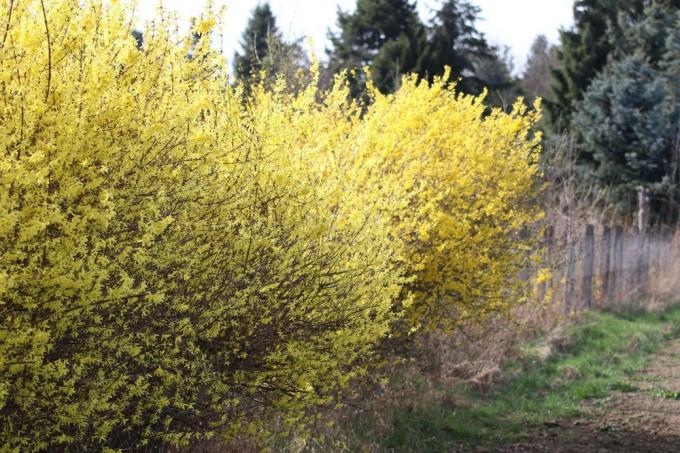
Flowering hedge plants with fruits for sandy soils
This trio of flowering hedge plants is not only easy to care for and enchants with an extraordinary one Abundance of flowers, the bushes also produce colorful fruits that glow in the garden in autumn and provide food for birds Offer. In addition, they are very undemanding in terms of location and soil conditions, so that they can also grow in gardens with rather sandy soil.
- Common snowball: white flowers in May / June
- Sand rose: pink flowers in June / July
- Sloe: white flowers in April / May
Flowering scented hedge
There are some trees that not only bloom beautifully, but also pamper you with a delicate fragrance. It is best to plant these shrubs as a hedge in a well-frequented place (for example along the driveway) so that you can enjoy the scent as often as possible.
- Winter honeysuckle: white flowers, depending on the weather between December and April
- Common lilac: white or purple umbels in May
- Winter flowers: creamy yellow flowers between December and March
- Privet: white umbels in June / July
- Snow forsythia: white blooms in the winter months
- Farmer's jasmine: white fragrant flowers in June / July

Evergreen flower hedge
Planting a hedge that is not only evergreen but also blooms is the dream of many garden owners. In addition to an expansive flowering hedge made of rhododendrons, combinations of the following hedge plants, which are evergreen, are also possible.
- Privet (evergreen varieties): white flowers in June / July
- Box-leaved barberry: golden yellow flowers in May
- Loosestrife: red or white flowers in May to June
- Evergreen viburnum: pink-white umbels in June

Combination in pink
If you want to use different plants that are similar in flower color, you can of course fall back on countless white flowering shrubs. A romantic pale pink combination consists of the following plants.
- Deutzia: light pink (May / June)
- Snow forsythia: soft pink (in the winter months)
- Weigela: pink (June / July)
- Mother of pearl shrub: pink (May / June)
